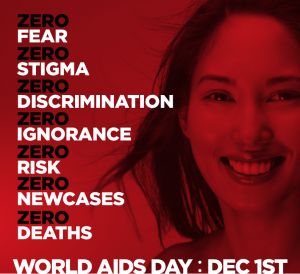By Trevor Storrs
Observed worldwide on December 1st since 1988, World AIDS Day is when millions of people come together across the globe to remember the people who lost their lives to HIV, celebrate the progress we have made towards eliminating the disease and recognize the hundreds of advocates who have fought against this epidemic. This year is significantly important because thirty years ago the world just started to learn about what would become known as one of the worst pandemics in history. On June 5, 1981, the Center for Disease Control (CDC) documented for the first time what became known as Acquired Immunodeficiency Syndrome (AIDS).
Over the course of the past thirty years, great strides have been achieved in learning how to prevent HIV/AIDS and ensuring those living with the disease have a positive quality of life. One of the major milestones achieved is the 15th anniversary of the introduction of highly active antiretroviral therapy (ART). ART revolutionized the treatment of the disease, transforming it from certain death to a chronic disease. 2011 not only marks the 30th anniversary of AIDS, it also marks the first time in history that AIDS will have been a treatable condition longer than it was the inevitably fatal disease first recognized. In addition, we have see activism and advocacy that profoundly influenced our nation’s response to HIV/AIDS, scientific advances resulting in the development of lifesaving, albeit not curative, treatment of HIV, and development of prevention tools that reduced the number of new infections.
In recognition of the work towards eliminating this disease from our communities, this year’s World AIDS Day theme embraces the concept of “ZERO”. Zero new cases, Zero discrimination, Zero stigma and most of all, Zero AIDS related deaths.
Zero may seem like a lofty goal but it is achievable. The number of new HIV infections and deaths in the world has been reduced by nearly 20%. Over 50 countries have either stabilized or significantly reduced the rate of new HIV infections. It is equally important to recognize these gains are fragile. By 2009, there were 2.6 million new HIV infections and 1.8 million people died from AIDS worldwide. Nationally, 1 in 5 individuals who are HIV positive don’t even know they are positive. In Alaska, over 1,400 individuals have been diagnosed with HIV since 1982. Each year, 30-40 Alaskans are diagnosed with HIV each year.
World AIDS Day is an opportunity for Alaskans to band together and help spread awareness about HIV/AIDS. I encourage all Alaskans to wear the universal symbol of AIDS awareness – a red ribbon. The ribbon signifies our commitment to eliminating HIV/AIDS and reminds us of the millions of lives we have lost to the disease. By wearing a red ribbon, we remind community members there is still work that needs to be done. It gives me great hope that an AIDS free generation is possible in our lifetime if we continue to enlighten and empower our community. Join me and take action on December 1st – together we can achieve Zero new cases, Zero discrimination and stigma and Zero AIDS related deaths.
The highlight of World AIDS Day will be a candlelight vigil held in both Anchorage and Juneau.
World AIDS Day Candlelight Vigils
Anchorage
Thursday, December 1, 2011 at 6 PM
Four A’s (1057 W Fireweed Ln, Ste 102)Juneau
Thursday, December 1, 2011 at 6 PM
Baranof Hotel (127 N Franklin St)In Anchorage, Four A’s volunteers will gather at the corners of Northern Lights and New Seward and Northern Lights and Minnesota from 7:00 a.m. to 9:00 a.m. to hold signs letting morning traffic know it’s World AIDS Day.
Red ribbons are available at many locations throughout Anchorage and Juneau.
The mission of the Alaskan AIDS Assistance Association is to be a key collaborator within the state of Alaska in the provision of supportive services to persons living with HIV/AIDS and their families and in the elimination of the transmission of HIV infection and its stigma.
It's all about life.





